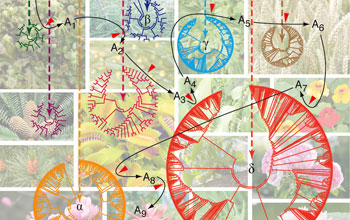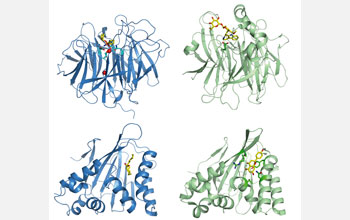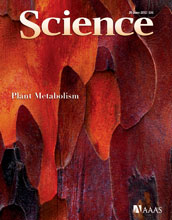All Images
News Release 12-118
Provocative Prescription for Chemical Evolution in Plants
Researchers speculate "specialized metabolism" was key to terrestrial takeover of plants
This material is available primarily for archival purposes. Telephone numbers or other contact information may be out of date; please see current contact information at media contacts.

According to researchers at the Salk Institute for Biological Studies and the Howard Hughes Medical Institute, primary metabolism likely arose from promiscuous primeval metabolic reactions and evolved toward greater catalytic precision and efficiency. This image illustrates the stepwise assembly of a specialized metabolic pathway using descendents from enzyme folds rooted in primary metabolism (indicated by circular phylogenetic trees and highlighted by Greek letters). Products of one reaction serve as substrates for another. Red arrowheads indicate the recruitment of single enzymes from protein families. The extensive radiation of the specialized metabolic system in plants have greatly contributed to plants' dominance in the terrestrial environments.
Credit: Jing-Ke Weng, Salk Institute
Download the high-resolution JPG version of the image. (918 KB)
Use your mouse to right-click (Mac users may need to Ctrl-click) the link above and choose the option that will save the file or target to your computer.

Salk Institute for Biological Studies researcher, Joseph Noel, and colleagues have been asking how has evolution shaped the complex natural chemistry of plants the world over and what role do these critical natural chemicals play in allowing plants to adapt to such a diverse set of complex and challenging ecosystems? This work funded for more than a decade by the National Science Foundation, is providing new discoveries in plant metabolism, their amazing chemistry and even the development of new technologies to benefit humankind in nutrition, disease prevention and the guilty pleasures of flavors and fragrances. More importantly though, this decade plus study, has provided unanticipated clues as to the rules governing the evolution of plant metabolism and their amazing repetoire of enzymes allowing humans to harness this information to engineer new kinds of metabolism for the burgeoning biorenewables and biofuels industries.
Credit: Jing-Ke Weng, Salk Institute
Download the high-resolution JPG version of the image. (941 KB)
Use your mouse to right-click (Mac users may need to Ctrl-click) the link above and choose the option that will save the file or target to your computer.

The researchers' work is described in the June 29, 2012 issue of the journal Science.
Credit: Copyright AAAS 2012
Download the high-resolution JPG version of the image. (1.5 MB)
Use your mouse to right-click (Mac users may need to Ctrl-click) the link above and choose the option that will save the file or target to your computer.


